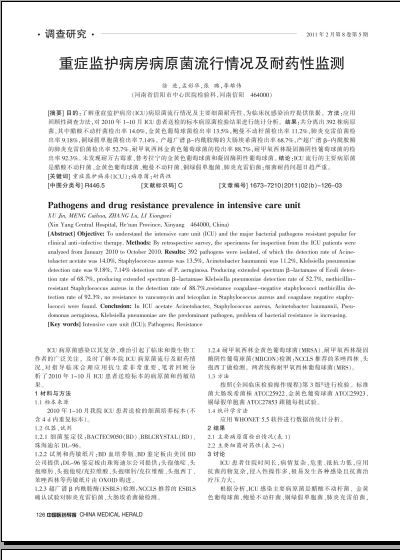重症监护病房病原菌流行情况及耐药性监测
 |
| 第1页 |
参见附件(2764KB,3页)。
[摘要] 目的:了解重症监护病房(ICU)病原菌流行情况及主要细菌耐药性,为临床抗感染治疗提供依据。方法:应用回顾性调查方法,对2010年1~10月ICU患者送检的标本病原菌检验结果进行统计分析。结果:共分离出392株病原菌,其中醋酸不动杆菌检出率14.0%,金黄色葡萄球菌检出率13.5%,鲍曼不动杆菌检出率11.2%,肺炎克雷伯菌检出率9.18%,铜绿假单胞菌检出率7.14%。产超广谱β-内酰胺酶的大肠埃希菌检出率68.7%,产超广谱β-内酰胺酶的肺炎克雷伯菌检出率52.7%,耐甲氧西林金黄色葡萄球菌的检出率88.7%,耐甲氧西林凝固酶阴性葡萄球菌的检出率92.3%。未发现耐万古霉素、替考拉宁的金黄色葡萄球菌和凝固酶阴性葡萄球菌。结论:ICU流行的主要病原菌是醋酸不动杆菌、金黄色葡萄球菌、鲍曼不动杆菌、铜绿假单胞菌、肺炎克雷伯菌;细菌耐药问题日趋严重。
[关键词] 重症监护病房(ICU) 病原菌 耐药性
[中图分类号] R446.5[文献标识码] C[文章编号] 1673-7210(2011)02(b)-126-03
Pathogens and drug resistance prevalence in intensive care unit
XU Jin, MENG Caihua, ZHANG Lu, LI Xiongwei
(Xin Yang Central Hospital, He'nan Province, Xinyang 464000, China)
[Abstract] Objective: To understand the intensive care unit (ICU) and the major bacterial pathogens resistant popular for clinical anti-infective therapy. Methods: By retrospective survey, the specimens for inspection from the ICU patients were analyzed from January 2010 to October 2010. Results: 392 pathogens were isolated, of which the detection rate of Acinetobacter acetate was 14.0%, Staphylococcus aureus was 13.5%, Acinetobacter baumannii was 11.2%, Klebsiella pneumoniae detection rate was 9.18%, 7.14% detection rate of P. aeruginosa. Producing extended spectrum β-lactamase of Ecoli detection rate of 68.7%, producing extended spectrum β-lactamase Klebsiella pneumoniae detection rate of 52.7%, methicillin-resistant Staphylococcus aureus in the detection rate of 88.7%,resistance coagulase-negative staphylococci methicillin detection rate of 92.3%, no resistance to vancomycin and teicoplan in Staphylococcus aureus and coagulase negative staphylococci were found. Conclusion: In ICU acetate Acinetobacter, Staphylococcus aureus, Acinetobacter baumannii, Pseudomonas aeruginosa, Klebsiella pneumoniae are the predominant pathogen, problem of bacterial resistance is increasing.
[Key words] Intensive care unit (ICU); Pathogens; Resistance
ICU病原菌感染以其复杂、难治引起了临床和微生物工作者的广泛关注,及时了解本院ICU病原菌流行及耐药情况,对指导临床合理应用抗生素非常重要,笔者回顾分析了2010年1~10月ICU患者送检标本的病原菌和药敏结果。
1 材料与方法
1.1 标本来源
2010年1~10月我院ICU患者送检的细菌培养标本(不含4 d内重复标本)。
1.2 仪器、试剂
1.2.1 细菌鉴定仪:BACTEC9050(BD)、BBLCRYSTAL(BD)、珠海迪尔DL-96。
1.2.2 试剂和药敏纸片:BD血培养瓶、BD鉴定板由美国BD公司提供;DL-96鉴定板由珠海迪尔公司提供;头孢他啶、头孢噻肟、头孢他啶/克拉维酸、头孢噻肟/克拉维酸、头孢西丁、苯唑西林等药敏纸片由OXOID购进。
1.2.3 超广谱β内酰胺酶(ESBLS)检测:NCCLS推荐的ESBLS确认试验对肺炎克雷伯菌、大肠埃希菌做检测。
1.2.4 耐甲氧西林金黄色葡萄球菌(MRSA)、耐甲氧西林凝固酶阴性葡萄球菌(MRCON)检测:NCCLS推荐的苯唑西林、头孢西丁做检测。两者统称耐甲氧西林葡萄球菌(MRS)。
1.3 方法
按照《全国临床检验操作规程》第3版[1]进行检验。标准菌大肠埃希菌株ATCC25922、金黄色葡萄球菌ATCC25923、铜绿假单胞菌ATCC27853跟随每批试验。
1.4 统计学方法
应用WHONET 5.5软件进行数据的统计分析。
2 结果
2.1 主要病原菌检出情况(表1)
2.2 主要细菌耐药性(表2~6)
3 讨论
ICU患者住院时间长,病情复杂、危重、抵抗力低,应用抗菌药物复杂,侵入性操作多 ......
您现在查看是摘要介绍页,详见PDF附件(2764KB,3页)。